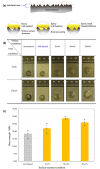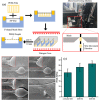Surface Treat Method to Improve the Adhesion between Stainless Steel and Resin: A Review
- PMID: 37929129
- PMCID: PMC10620901
- DOI: 10.1021/acsomega.3c05728
Surface Treat Method to Improve the Adhesion between Stainless Steel and Resin: A Review
Abstract
Combining metal and polymer into hybrid composite materials is finding increasing interest in many industries. Special attention is being paid to increase the adhesion between the metal and polymer interface. In this paper, the current research progress of surface treatment methods for improving the interfacial adhesion of stainless steel and resin is reviewed. It involves the stainless steel surface treatment method, resin surface treatment method, and adhesion test methods of stainless steel and resin. The methods of improving the interfacial adhesion of stainless steel and resin are summarized and prospected according to the research status.
© 2023 The Authors. Published by American Chemical Society.
Conflict of interest statement
The authors declare no competing financial interest.
Figures


















References
-
- Jin Z.; Han Z.; Chang C.; et al. Review of methods for enhancing interlaminar mechanical properties of fiber-reinforced thermoplastic composites: Interfacial modification, nano-filling and forming technology. Compos. Sci. Technol. 2022, 228, 109660.10.1016/j.compscitech.2022.109660. - DOI
-
- Yao S. S.; Jin F. L.; Rhee K. Y.; et al. Recent advances in carbon-fiber-reinforced thermoplastic composites: A review. Composites Part B: Engineering 2018, 142, 241–250. 10.1016/j.compositesb.2017.12.007. - DOI
-
- Khan R. Fiber bridging in composite laminates: A literature review. Composite Structures 2019, 229, 11141810.1016/j.compstruct.2019.111418. - DOI
-
- Zhang J.; Chevali V. S.; Wang H.; et al. Current status of carbon fibre and carbon fibre composites recycling. Composites Part B: Engineering 2020, 193, 10805310.1016/j.compositesb.2020.108053. - DOI
Publication types
LinkOut - more resources
Full Text Sources

